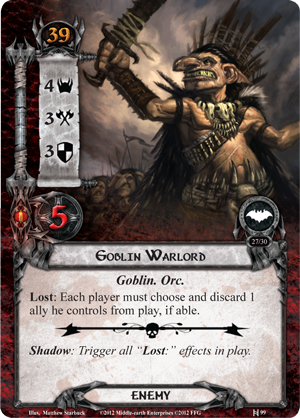Monday, January 30, 2012
Tuesday, January 24, 2012
Tuesday, January 17, 2012
NinjaDorg's The Lost Road - ace review at La Taverne du Jeu
Our good friend freourslc over at the Tavern has delivered this brilliant, humbling assessment of our very own Lost Road solo adventure for The Lord of the Rings: The Card Game. Be sure to check it out here:
'via Blog this'
Thursday, January 12, 2012
The Long Dark of Moria

It was after nightfall when they had entered the Mines. They had been going for several hours with only brief halts, when Gandalf came to the first serious check. Before him stood a wide arch opening into three passages: all led in the same general direction, eastwards; but the left-hand passage plunged down, while the right-hand climbed up, and the middle way seemed to run on, smooth and level but very narrow.
–The Fellowship of the Ring
–The Fellowship of the Ring
Fantasy Flight Games is pleased to announce the upcoming release of The Long Dark, the fourth harrowing Adventure Pack in the Dwarrowdelf cycle for The Lord of the Rings: The Card Game!
After a brutal conflict with The Watcher in the Water, several heroes of Middle-earth pass through the gates of Moria and begin to scout its ancient tunnels for the root of the increased Orc activity in the Misty Mountains. But it has been many ages since the Dwarves last gave light to the mines. The way is dark and choked with foes and hazards. The ominous dark lingers ever before your party, closing in around you, making it difficult to tell one path from another, and you must be careful to keep your way…
The Orcs of Moria are multitude, but your heroes seek signs of the forces that draw the Orcs together and drive them out into the mountains. As your heroes begin their journey into The Long Dark, they find pockets of Goblin resistance, but with little organization save for that provided by Goblin warlords. To discover the deeper roots of the increased Orc activity, your heroes must delve deeper into the Mines.
The Long Dark introduces 60 new cards, including a new hero, three copies of each player card, and an all-new scenario that pits your heroes against bands of Goblins, the hazards of traveling in the dark, and the risk of getting lost. As your heroes travel through the Dark, Underground realm of Moria, they must navigate carefully or suffer the consequences of losing their way. Any wrong turn may tax your heroes’ energy and limit their options, discarding cards from your hand, or it may lead into a host of Orcs, spiders, and rock adders.
The wealth of Moria
“The wealth of Moria was not in gold and jewels, the toys of the Dwarves; nor in iron, their servant.”
–Gandalf, The Fellowship of the Ring
–Gandalf, The Fellowship of the Ring
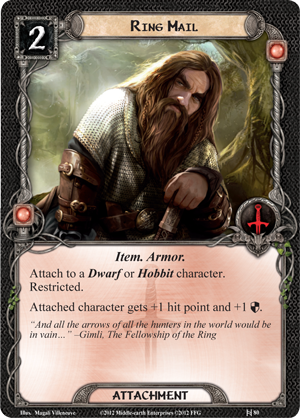 The Long Dark poses unique challenges to your band of heroes, but it also provides them with new resources. Four new allies offer their assistance, and your heroes can make use of a number of new events and attachments, including sturdy Ring Mail (The Long Dark, 80).
The Long Dark poses unique challenges to your band of heroes, but it also provides them with new resources. Four new allies offer their assistance, and your heroes can make use of a number of new events and attachments, including sturdy Ring Mail (The Long Dark, 80).Originally shown in the announcement of the Dwarrowdelf cycle, Ring Mail has already spurred conversations among fans on our community forums. With the release of The Long Dark, you will be able to better protect your Dwarf and Hobbitcharacters from the hordes of Orcs and Goblins that harry your fellowship through the mines. Perhaps, the extra defense your heroes gain from their Ring Mail may be the edge between success and failure in their quest.
Don your Ring Mail, stock up on provisions, and prepare yourselves for adventure as your party sets foot into the mines of Moria and confronts The Long Dark that awaits them. This challenging and suspenseful Adventure Pack is scheduled to release in the second quarter of 2012!
Tuesday, January 10, 2012
Boromir's Guide to Deck Construction, Part One
Fantasy Flight Games [News] - Boromir's Guide to Deck Construction, Part One:
'via Blog this'
'via Blog this'
“Believe not that in the land of Gondor the blood of Númenor is spent, nor all its pride and dignity forgotten. By our valour the wild folk of the East are still restrained, and the terror of Morgul kept at bay; and thus alone are peace and freedom maintained in the lands behind us, bulwark of the West.”
–Boromir, The Fellowship of the Ring
–Boromir, The Fellowship of the Ring
One of the reasons The Lord of the Rings: The Card Game has entertained so many fans and enjoyed a great deal of success is because it appeals to people across a range of player archetypes–Bilbo, Pippin, and Boromir alike. The game’s narrative structure makes it easy to find a story in every game. Because it’s a Living Card Game, novelty seekers can find new cards to try in their decks and new challenges to face with each monthly release, and enough of the scenarios and their enemies pose sufficient threat to challenge the hardcore Boromirs, who seek glory through conquest. In fact, some of us are still waiting for the combination of cards that will allow us to beat Escape from Dol Guldur solo with a measure of consistency.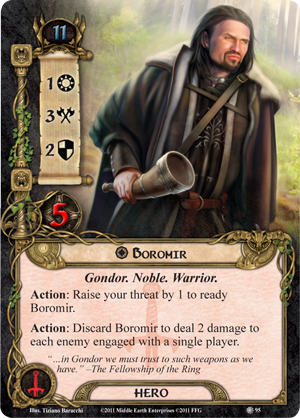

The lone traveler’s journey
The game has also found a good measure of success due to its rich solitaire play, but while confronting the challenges of Middle-earth may lead to memorable game experiences, they can also frustrate players with less experience in games with deck construction. The Lord of the Rings: The Card Game is unique among these games in that players compete against the forces of Shadow, as controlled by an encounter deck and its artificial intelligence. Still, the encounter deck has its fair share of devious tricks and an arsenal of deadly weapons. Accordingly, it is no simple thing to master the encounter deck and succeed at your quests.
Now that the Khazad-dûm Expansion has arrived, players will face a whole host of new challenges, and some have already wondered how they will fare against the goblin hordes of Moria.
Today, then, we begin a three-part series of deck-building tutorials aimed at the new solo player, but one that should contain helpful information (and reminders) for players of all experience levels.
Sharpening your blade
There’s much to be said for the decisions you make while playing a game, but we begin any conversation about success in a card game by looking at the deck.
While players may find many different card combinations and ways to approach the challenges before them, there are a number of larger, universal concerns that touch upon deck-building in any game, including The Lord of the Rings: The Card Game. No matter the scenario you intend to conquer, you’ll want to consider how your deck may provide you with action advantage, card advantage, and resource acceleration. Additionally, every card designer at some point talks about “synergy,” and it’s important to be able to recognize whether or not your deck is filled with synergies between cards, or if it’s a combination of 50 cards all seeking to do their own thing. Meanwhile, each card game introduces its own game-specific concerns, and in The Lord of the Rings: The Card Game, it’s always worth trying to maintain as low a starting threat as possible, and including some means of reducing it should it start to rise.
Today, we’ll go into a bit more depth about action advantage and card advantage.
Action advantage
Action advantage refers, generally, to the idea that you can do more than your opponent each turn. In a head-to-head game, like A Game of Thrones: The Card Game, you might gain action advantage through “board control” or a stronger “board position.” In short, if you have more and stronger characters on the table than your opponent, you’re more likely to win challenges and the game. In The Lord of the Rings: The Card Game, your heroes are limited in what they can do by the number of times they can exhaust. Do you choose to quest with your hero, defend, attack, or exhaust to use a special ability? Each of these is an “action,” and the more actions you can take, the better.
Part of the solution is to include allies. A lot of allies. Many successful decks are almost half full of allies. Allies who can quest allow your heroes to attack or defend. Allies who block enemies for your heroes allow your heroes to quest or attack. Allies are good and help you gain action advantage.
Another part of the solution is to build your deck around heroes who can ready themselves. Aragorn (Core Set, 1),Prince Imrahil (A Journey to Rhosgobel, 50), and Boromir (The Dead Marshes, 95) all come to your fellowship with built-in means of readying themselves. Still, there are other means of readying your heroes. Spirit heroes can help others find Unexpected Courage (Core Set, 57) or recruit a Westfold Horse-Breaker (The Hunt for Gollum, 6), and now, with the release of Khazad-dûm, your Dwarf heroes can get a boost from the Erebor Record Keeper (Khazad-dûm, 11).
Khazad-dûm introduces another card that clever players may use to find action advantage, Ever Onward (Khazad-dûm, 5). Certainly not the most glamorous of cards, Ever Onward may appear at first glance as though it’s merely a safety net. However, if you know you won’t fall deeper into threat by failing at your quest, Ever Onward can afford you a single turn in which for three-cost, all your characters remain ready to confront the enemies with which they are engaged, allowing you to withhold them from questing and assign them, instead, to defense and attack.
You can even find action advantage from cards that don’t provide you with extra actions but can let you “cheat” around the need to take actions. For example, Dúnhere (Core Set, 9) and Quick Strike (Core Set, 35) can let you attack enemies without first having to defend against them. They can save you the need to heal your characters later, prevent nasty shadow effects from resolving, and free you to focus on questing successfully.
Card advantage
Card advantage comes primarily in four forms. One is card draw. The more cards you can draw, the more options you hold in your hands. Another is subtler but no less effective, and that is the ability to do more with fewer cards. The final routes to card advantage are search and recursion.
There are only a handful of cards in The Lord of the Rings: The Card Game that accelerate card draw, and the best of them are ubiquitous among top players. Beravor (Core Set, 12) almost always receives the first copy (or two, or three) of Unexpected Courage when she’s present in the party. While it may seem like a waste of an action to exhaust her to draw cards rather than quest, defend, or attack, nothing could be further from the truth. Card draw is the backbone of versatility. The more cards you hold in your hand, the likelier you’ll be able to find the perfect response to any threat. Furthermore, if another of your heroes is a Protector of Lórien (Core Set, 70), you can convert Beravor’s card draw directly into extra Willpower toward the quest. Bilbo (The Hunt for Gollum, 1), Gléowine (Core Set, 62), and Ancient Mathom (A Journey to Rhosgobel, 56) also provide excellent card draw, as can Gandalf (Core Set, 73), when he isn’t busy wounding enemies or lowering your threat.
Gandalf’s versatility serves as an excellent illustration of the second type of card advantage. Not only is he a powerful ally with tremendous benefits while questing, defending, or attacking, but he also offers your party the pick of his three exceptional abilities whenever he comes into play. At five cost, he’s not cheap, but the combination of Gandalf andSneak Attack (Core Set, 23), both reduces the wizard’s cost and allows you to play him more times. This combination offers classic card advantage. Dwalin (Khazad-dûm, 1) offers similar card advantage with his ability to reduce your threat each time he defeats an Orc. The mines of Moria are filled with Orcs, after all, and if you can boost his strength, Dwalin can both clear away your enemies and control your threat, saving you a card slot you might otherwise spend onThe Galadhrim’s Greeting (Core Set, 46).
Finally, cards that search your deck, reorder the cards on top of your deck, or pull other cards out of your discard pile may not provide you with more options in your hand, but they may ensure you hold the right cards. Dwarven Tomb(Core Set, 53) can be as good as any Spirit card in your discard pile. Gildor Inglorion (The Hills of Emyn Muil, 79) is good not only for his excellent statistics; his ability to manipulate the top three cards of your deck can help you find the cards you need earlier than you would otherwise. Gildor’s search ability can also ensure the success of your Zigil Miner (Khazad-dûm, 9), leading to rapid resource acceleration… a fundamental of deck-building.
Saturday, January 07, 2012
Open Wide the Gates of Moria
Fantasy Flight Games [News] - Open Wide the Gates of Moria:
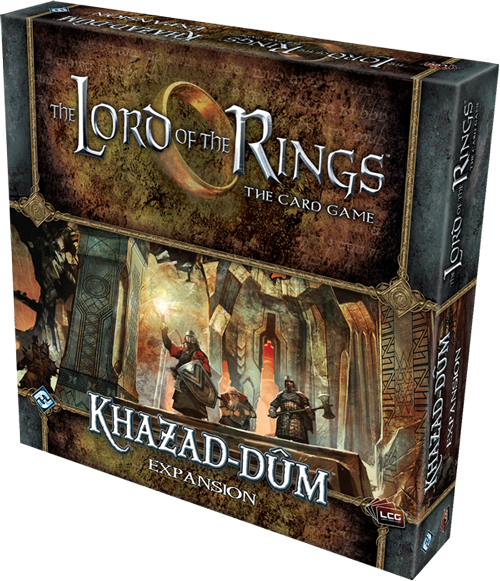
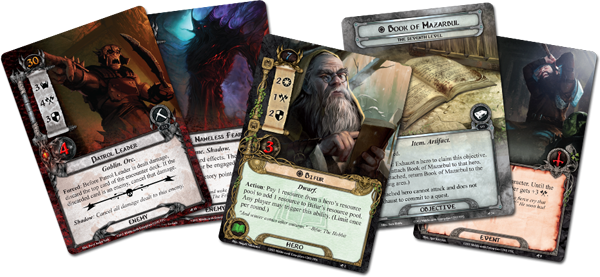

“It is now many years ago,” said Glóin, “that a shadow of disquiet fell upon our people. Whence it came we did not at first perceive. Words began to be whispered in secret: it was said that we were hemmed in a narrow place, and that greater wealth and splendour would be found in a wider world. Some spoke of Moria: the mighty works of our fathers that are called in our own tongue Khazad-dûm; and they declared that now at last we had the power and numbers to return.”
–J.R.R. Tolkien, The Fellowship of the Ring
–J.R.R. Tolkien, The Fellowship of the Ring
The hour of the Dwarves has come. The Khazad-dûm Expansion for The Lord of the Rings: The Card Game is now on sale at your local retailer and online on our webstore. Pick up your copy today!
Great works begun there
Over time, the whispers of wealth and splendour touched Dwarven hearts and created stirrings within them that would not be quieted. Finally, Balin resolved to explore the mines of Moria and reclaim its treasures for the Dwarves. Ori, Oín, and many other Dwarves traveled with him, and the initial reports they sent back to the other Dwarves told of their entry and the great works they had begun. Then, however, the messages ceased. No word has arrived from Balin in many years.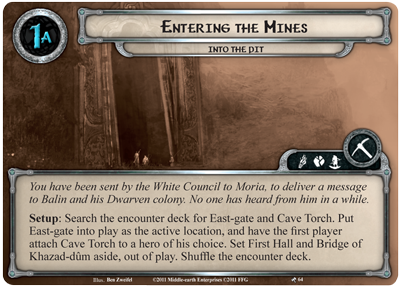

In Khazad-dûm, a trio of thrilling scenarios take some of Middle-earth’s greatest heroes on daring adventures to Moria, where they search for Balin and his fledgling Dwarven colony.
Balin’s fate is of tremendous concern to the Dwarves, and they offer as much aid as they can in Khazad-dûm. You’ll find new attachments and events to bolster your Dwarves, along with newDwarf allies and two fantastic new Dwarf heroes. Each player card comes in triplicate, so a single copy of Khazad-dûm provides you with a complete play set of all its new cards.
Journeys in the dark
Your heroes’ search for Balin will lead them deep into the mines of Moria and its Dark corners and corridors. The subterranean world of Khazad-dûm is unlike anything your heroes faced in the Core Set or the Shadows of Mirkwoodcycle, and the expansion introduces nine new encounter sets to represent the mines’ new perils. From frightening new locations and treachery cards reflecting the physical dangers of travel through Moria to Orcs and Trolls, Khazad-dûm pushes the game forward with exciting new encounter themes and mechanics.

The wait for this highly anticipated expansion for The Lord of the Rings: The Card Game has finally come to an end, and the time has come to begin your journeys through Khazad-dûm.
Thursday, January 05, 2012
NinjaDorg's Fortune And Glory: The Cliffhanger Game Review

Prelude:
Flying Frog Productions bring us another attention-grabbing genre movie, sorry game, with Fortune and Glory: the Cliffhanger Game. The same PhotoShop -> Filter -> Artistic -> Drybrush effect is used once again throughout the design of the game on a series of photos of actors, models and friends of the game’s makers in period outfits, posing at various locations with lots of interesting props. Some people might not like this design format, and whilst I usually prefer digital/painted artwork I must say I like it a lot, and think it nicely fits that B-movie feel FFP’s games have, whilst also letting their games stand out from the crowd.
Biases - I love A Touch Of Evil and Last Night On Earth, but don’t like the look or theme of Conquest of Planet Earth or Invasion From Outer Space.
What is it?
‘Indiana Jones: the Board Game’ without the appropriate licensing. No getting around this glaring comparison. FANG homages old school pulp adventure stories/comics/movies and lets the players become have-a-go heroes who take on the evil Nazis (or the curiously worldwide mob if you prefer) in a race around the planet to accumulate allies and gear and find artifacts of great power that will save or destroy the world.
How does it play?
Roll for initiative, roll for move, draw a (usually) nice Event card if you get a 1 on either roll, move to a location, flip a card, try to find an artefact by overcoming a series of dangers/encounters, gain Glory for successful encounters, use Glory to buy stuff, take artifact back to a city to sell it for Fortune, repeat until you get 15 Fortune and win. This is not a Euro.
The main element is that you’re chasing artifacts which are “dynamically generated” - two cards are put together to determine the artifact’s type and object, e.g. ‘The Eyes’ artifact with ‘of Medusa’ adventure. Each has a number of dangers you must overcome and if you fail one you flip the danger card over to reveal a ‘Cliffhanger’. Your turn ends and you must overcome this more deadly danger on your next go or get KO’d and lose stuff.
What are the bits like?
For the most part, Glorious:
The map of the earth is a really beautiful board – on a par with the Tales of the Arabian Nights earth map, which I feel is really saying something. It evokes the unexplored, exaggerated feel of the time with an emphasis on theme with countries like “The Heart of Africa” and “Amazon Falls” rather than geographical accuracy/consistency. Also feels pretty sturdy.
The minis are really great quality and are what you have come to expect from FFP, with a range of heroes and villains and their henchmen, some temples, and a nice Zeppelin to boot.
FFP’s cards – and there are hundreds of them in FANG - might actually be my favourite in any board game. They feel so sturdy I haven’t yet sleeved an FFP game. Love them. They also look great too, really like how they’ve captured all the different elements. And there is lots of replayability in there – you’ll barely touch most of the decks in a given game and there are a lot: Events, City events, Enemies, Nazi Enemies, Gear, Allies, Adventure/Artifacts.
Great tokens, nicely designed, tactile, thick and generally easy to see on the board. Again, a great standard maintained by FFP.
16 dice. Can’t have too many dice. You get 8 white for the heroes, and 8 green for the villains. Though having rolled better with the greens repeatedly, I switched em around. Scientific logic that.
But occasionally, UnFortunate:
Over 100 plastic coins! This was a big mistake I feel, the ‘5’s can be hard to distinguish from the ‘1’s at a glance, and the plastic is ugly, garish blue and off-yellow/gold and pointless. It looks like it’s from my two year old’s cash register toy. Cardboard tokens like the Investigation tokens from ATOE would have been much better and prettier, and presumably less costly for all involved. Worst of all, the box cover advertises “over 160 plastic bits” without the addendum “most of which are these garbage toy coins”.
Music – the included CD is the same quality as the other FFP games. And love it or hate it, my strong feeling is that these should be optional, rather than included in the box.
Massive – the box is really massive, and doesn’t really warrant the space. Only the board fills it, so if that had come in two parts or something they could have made it LNOE/ATOE sized, or maybe the size of the D&D Adventure System games. As it is the thing is pretty unwieldy and difficult to store.
What’s new for FFP?
I think scope is what they were going for with this one. There’s a high-falutin’ sense of adventure as you race around the world hunting for ancient temples and treasures and fending off villains, racing down city streets or crashing cargo planes into mountains. And the array of elements included in the gameplay such as various effects on artifacts you are pursuing (some positive, some negative), the spread of villainous henchmen across the world, collapsing temples, a roaming Zeppelin dispensing Nazis around the globe, evil hideouts to raid, the events and dangers of exploring cities, all these help feed the idea of a living world you’re exploring. But it’s all very much an evolution of the A Touch Of Evil (and Last Night On Earth to a lesser extent) gameplay, so if you didn’t like that game then the chances are that this one won’t blow your mind.
How is it better than LNOE/ATOE?
More cards, feels like more variation and depth.
The best FFP board yet, puts the ATOE map board to absolute shame - and I liked it!
Feels more streamlined and fleshed out in its gameplay.
You can play cooperative, competitive, solo, or team games.
The Villains’ AI is simple but effective, and really puts the pressure on you when you’re racing for the same artifacts.
You can fight Nazis! Just waiting for those LNOE Nazi zombies to turn up in LNOE now...
How is it worse than LNOE/ATOE?
FANG takes a longer time to play, and takes up more space.
It’s more expensive, and you don’t get significantly much more game for all that extra cash. I got bought this as a great surprise Christmas pressie, but I probably wouldn’t have opted for it myself given the price point. Which is a shame because I’d have missed out on a great game.
The Dangers are limited – as has been stated on the BGG forums before, there just aren’t enough Dangers, and these are the main challenges in the game. For the first few games you won’t notice but when the same ones start emerging after repeated plays it can get samey, even if each has two possible Cliffhangers, chances are you (hopefully) won’t see them anyway.
If I only get one of the three games, which should it be?
Damn, why did I include this question?? It’s a tricky one, and probably comes down to which theme you prefer. Which I think is a testament to FFP’s design skills. I probably prefer A Touch Of Evil but I have all the expansions for that game so it’s an unfair comparison.
Pricewise ATOE and LNOE give probably as much game in the box, so it’s best to start with one of those first to see if you enjoy FFP’s design style, since it is very similar across all their games. Unless your love for pulp adventures trumps zombies or gothic horror of course...
What’s the difference between Fortune and Glory?
I used to know before I played this game but now I don’t anymore! For some reason you purchase things with Glory whilst your hero’s ultimate quest is to amass the most Fortune. Which makes everyone seem more mercenary than heroic. This has irked more than one or two people, and I still find the game designer Jason Hill’s explanation bewildering. But seriously, you’ll soon get over this grammatical curiosity after a game or two and just get on with the adventuring.
Is it any good?
Yes.
There’s a lot going on in this game, and it feels like lessons have been learned from the previous releases even if they are mostly baby steps, like having the option of fixed movement for those who don’t like rolling to see ho far they can go, or making something potentially happen in every single space on the board. The rules took a while to digest, and because there’s a lot going on it’s easy to miss or forget things on your first few plays. And I still can’t find an explanation of the Fortune bonus on Location cards (we just stick the bonus under the artifact card if applicable).
In a turn you have a decent choice of options – I’d read that people thought there was no skill involved and that you just go for the nearest artefact but I often found myself having to choose between different locations and whether or not to chance a city or event or an enemy, or try and pick up an event card en route to an adventure, or whether or not to try and camp down and heal instead of pressing on.
Overall: it’s a lot of fun! It plays well and turns go quickly as downtime is spent watching others encounter a series of dangers and praying for their downfall (not played the coop version yet). It can be a bit faltering as you get the rules down – there are a few more rules than I’d expected after A Touch Of Evil. I’ve played a metric tonne of solo games and it’s still set up on our table for another multiplayer game tonight. The solo game is hard to lose, you’ll soon want to ramp up the difficulty on that, similar for cooperative games. But the competitive game is a heart pounding race to the finish.
It’s early to say but I reckon it’s up there with LNOE and ATOE, both of which I love. And the soloable aspect is a huge bonus for me for when the wife is watching Eastenders, etc.
Summary
If money is no object, jump on in. Otherwise you might want to consider your other options first. Here’s a recap of the pros and cons...
Pros:
Fun game!
Really beautiful board
Brilliant cards
Cool minis
Great theme – really well implemented, smash those nazi scum!!
Lots of replayability in most of the card decks
Fast paced – actions are resolved quickly with a few dice rolls
Good choice of options in a turn
1-8 players
Option to play coop, solo, competitive, or in teams
Cons:
Price – very high for what you get (your country’s price may vary)
Rubbish plastic coins!
Music CD
Mahoossive box
Limited dangers
Subscribe to:
Posts (Atom)




